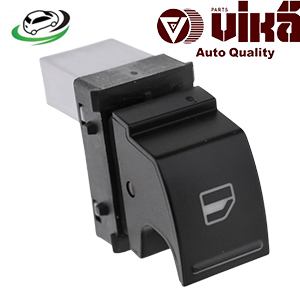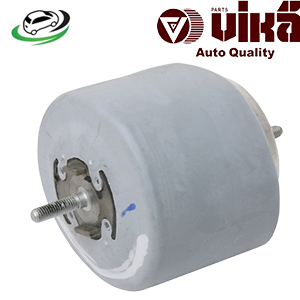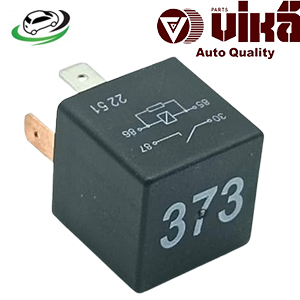-20%
Get VW EOS/Golf/Passat/Tiguan / AUDI A4 A8 Relay Control 8D0951253A
A relay is an electrically operated switch that allows a low-power control signal to manage a higher-power electrical circuit. It is essential in systems where direct control would demand large, unwieldy wiring and switches. The relay acts as an intermediary between the control circuit and the high-power circuit, providing a way to handle electrical loads safely and efficiently.
For example, in an automobile, the relay controls various systems like the headlights, air conditioning, or the starter motor. Instead of routing all the electrical current through a switch on the dashboard (which would require heavy-duty wiring), the relay enables the current to be controlled indirectly through a small, low-power switch.
Key Components
- Electromagnet (Coil): The core of the relay, responsible for generating a magnetic field when energized. This magnetic field pulls the relay contacts together or apart, controlling the flow of current in the circuit.
- Switching Mechanism (Contacts): These are the points that open or close the circuit based on the electromagnet’s action. The two main types are:
- Normally Open (NO): The circuit is open when the relay is at rest and closes when the relay is activated.
- Normally Closed (NC): The circuit is closed when the relay is at rest and opens when the relay is activated.
- Armature: The armature is the moving part of the relay that connects or disconnects the contacts when the electromagnet is energized.
- Spring Mechanism: Returns the armature to its original position when the relay is de-energized, allowing the contacts to open or close depending on the relay type.
- Diode (Optional): In some relays, a diode is included to protect sensitive electronics from voltage spikes when the electromagnet deactivates.
2. Types of Relays
Relays come in various forms to suit different applications, each with unique features and benefits. The main types include:
1. Electromechanical Relay (EMR):
This is the most common type of relay, which uses an electromagnet to mechanically open or close contacts. EMRs are highly reliable and used in a wide range of applications, from automotive systems to industrial equipment.
2. Solid-State Relay (SSR):
Instead of mechanical contacts, SSRs use semiconductor components to switch the circuit. They are faster, more durable, and more reliable than EMRs in environments with frequent switching and high vibrations. However, they can be more expensive.
3. Time-Delay Relay:
This relay incorporates a built-in delay before switching the circuit, often used in applications where timing is critical, such as HVAC systems or engine start circuits. They can be further classified into:
- On-Delay: Delays the activation of the circuit.
- Off-Delay: Delays the deactivation of the circuit.
4. Latching Relay:
A latching relay remains in its last state (either open or closed) even after power is removed. This feature makes it ideal for applications where power consumption needs to be minimized, such as battery-operated devices or systems with intermittent power supply.
5. Relay Modules:
These are pre-packaged relay circuits that include the necessary components for controlling multiple relays from a central unit. They are often used in complex systems requiring multiple circuits to be controlled independently.
3. Benefits of Relay Control
Relays offer numerous advantages, making them indispensable in many electrical systems:
1. Isolation:
Relays provide electrical isolation between the control circuit and the high-power circuit. This prevents the control circuit from being exposed to dangerous high voltages or currents, ensuring safer operation.
2. Power Handling:
Relays allow small control circuits to manage large electrical loads, significantly reducing the amount of heavy-duty wiring required.
3. Durability:
Relays are designed to withstand high electrical currents and frequent operation. Solid-state relays, in particular, offer a long operational life with minimal wear.
4. Versatility:
Relays can be used in a wide range of applications, from automotive systems to industrial machinery, HVAC units, home automation, and more. They can control AC and DC circuits, making them adaptable to different types of electrical systems.
5. Low Power Consumption:
Relays, especially solid-state ones, consume very little power when they are in operation, making them efficient in systems where power conservation is critical.
4. Common Applications of Relays
Relays are used in a variety of automotive and industrial applications. Here are some common examples:
1. Automotive Systems:
Relays are widely used in vehicles to control components like headlights, horns, fuel pumps, and ignition systems. They reduce the need for heavy wiring by allowing the switch to manage the circuit indirectly.
2. HVAC Systems:
Heating, ventilation, and air conditioning (HVAC) systems often use relays to control fans, compressors, and other large components based on the temperature and other sensor readings.
3. Home Appliances:
Relays are used in refrigerators, washing machines, and other household appliances to switch high-power devices on and off, such as motors and compressors.
4. Industrial Machinery:
In factories, relays are used in control panels to manage large motors, pumps, and other machinery. Time-delay relays are often used to coordinate the start-up sequence of multiple devices.
5. Common Issues with Relays
Like any electrical component, relays can encounter issues over time. Some of the most common problems include:
1. Contact Wear:
Mechanical relays rely on contacts to switch the circuit. Over time, these contacts can wear out, causing intermittent connections or complete failure.
2. Coil Burnout:
The coil in a relay can become damaged due to overheating or excess voltage, preventing the relay from activating.
3. Sticking Contacts:
In some cases, the contacts may become stuck in the closed position, causing the circuit to remain on even when the control signal is removed. This can be due to welding of the contacts under high loads.
4. Faulty Wiring:
Poor wiring connections can cause intermittent relay operation or failure. Frayed wires, loose connections, or corrosion can all contribute to relay problems.
5. Voltage Spikes:
When a relay deactivates, it can generate a voltage spike that may damage sensitive electronic components in the circuit. This is especially common in automotive systems.
6. Maintenance and Troubleshooting
To ensure reliable relay operation, follow these maintenance tips and troubleshooting steps:
1. Regular Inspection:
Periodically check relays for signs of wear, corrosion, or overheating. This can help prevent failure and ensure proper operation.
2. Clean Contacts:
If a relay is operating intermittently, the contacts may be dirty or corroded. Use a contact cleaner to remove debris and restore proper connection.
3. Test the Coil:
If the relay is not activating, use a multimeter to test the resistance of the coil. If the resistance is too high or low, the coil may be damaged and require replacement.
4. Check for Voltage Spikes:
If your circuit includes sensitive electronics, consider using relays with built-in protection diodes to prevent damage from voltage spikes.
5. Replace Worn Relays:
Relays have a limited lifespan, especially in systems with frequent switching. If a relay is showing signs of wear or failure, replace it with a suitable replacement.
7. Relay Replacement
Replacing a faulty relay is a relatively straightforward process. Here’s a basic guide:
Tools and Materials Needed:
- Screwdriver or socket set
- Replacement relay
- Multimeter (optional)
Replacement Steps:
- Disconnect Power:
- Before working on any electrical system, disconnect the power supply to avoid shocks or short circuits.
- Locate the Relay:
- In vehicles, relays are often located in the fuse box or under the dashboard. In industrial systems, they may be found in control panels.
- Remove the Old Relay:
- Carefully pull the relay from its socket. If necessary, use a screwdriver to release any clips holding the relay in place.
- Test the New Relay (Optional):
- Before installing the new relay, use a multimeter to check the continuity of the contacts and the resistance of the coil.
- Install the New Relay:
- Insert the new relay into the socket, ensuring that the pins are properly aligned.
- Reconnect Power and Test:
- Once the relay is installed, reconnect the power supply and test the circuit to ensure proper operation.
Conclusion
Relay control is an integral part of modern electrical systems, providing a reliable and efficient way to manage high-power circuits with low-power signals. Whether in automotive applications, home appliances, or industrial machinery, relays offer numerous benefits, including electrical isolation, durability, and power efficiency. By understanding their function, components, and common issues, users can maintain these devices and ensure long-term performance. Regular inspection and proper maintenance are key to preventing relay failures and ensuring the safety and functionality of the system.
Follow us on Facebook for more parts.




Reviews
Clear filtersThere are no reviews yet.